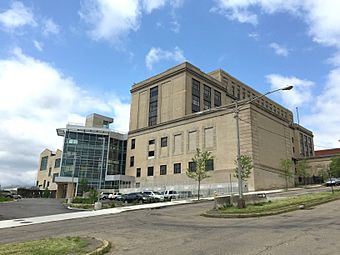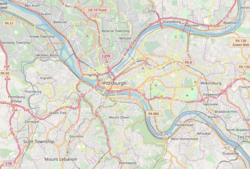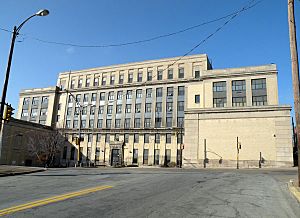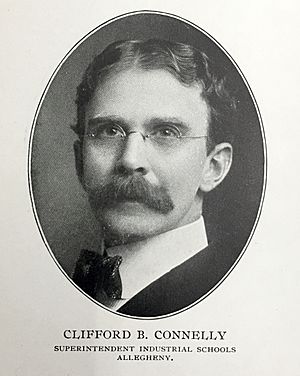Energy Innovation Center facts for kids
Quick facts for kids Energy Innovation Center |
|
|---|---|
|
Clifford B. Connelley Trade School
|
|
 |
|
| Location | 1435 Bedford Avenue (Crawford–Roberts), Pittsburgh, Pennsylvania |
| Built | 1930 |
| Architect | Edward B. Lee, J.G. Fullman Co. |
| Architectural style | Classical Revival |
| Website | EICPittsburgh.org |
| NRHP reference No. | 86002661 |
| Significant dates | |
| Added to NRHP | September 30, 1986 |
The Energy Innovation Center is a special place in Pittsburgh, Pennsylvania. It brings together many different things. It has programs to help people learn job skills. It also has labs for researching "green" technology. This means technology that is good for the environment. The center also helps new businesses grow. Plus, it works with universities on projects.
This center is located in an old building. It used to be the Clifford B. Connelley Trade School. The building was updated to fit its new uses. It also became a great example of "green adaptive reuse." This means taking an old building and making it useful again in an eco-friendly way. In 2014, the updated building won an award for being sustainable. It is also listed as a historic place. This makes it a unique building. It's one of the only super green buildings (LEED Platinum) that also gets special tax help for being historic.
Contents
Making the Building New Again
The idea for a center focused on green energy started with some politicians. They wanted to help the economy grow in an environmentally friendly way. In 2008, many groups came together. These included non-profits, unions, and universities. They formed a group called Pittsburgh Green Innovators. Their goal was to support green growth in the community.
One main goal was to create a new school. This school would teach skills for jobs that are in high demand. These jobs would be in green energy and sustainability. The old Connelley Trade School building was suggested as a good spot. The Connelley School used to be a leader in job training. But fewer students enrolled as Pittsburgh's population got smaller. So, the school closed in 2004.
The Pittsburgh Green Innovators realized the project was too big for them alone. So, they asked Pittsburgh Gateways Corporation to help. This is a local non-profit group that develops buildings. Pittsburgh Gateways rented the empty Connelley building. They later bought it in 2011.
In 2012, they started renovating the building. They got permission from the National Register of Historic Places. DLA+ Architects designed the plans. Mascaro Construction was the main builder. Pittsburgh Gateways led the huge renovation. Their goal was to make the old building meet LEED Platinum standards. This is the highest level of green building certification. The project cost about $40 million. Construction started in February 2013. In 2014, the building reopened as the Energy Innovation Center. Its address also changed.
The renovation focused on being good for the environment. They had a plan to take apart the old building carefully. They saved materials to keep them out of landfills. The project is still being finished. But it is expected to get LEED Platinum certification. It also aims to meet strict goals for reducing energy and water use. It also plans to lower transportation pollution.
History of Connelley Trade School
How It Was Built and Opened
The Connelley Trade School is on a large piece of land. It is in the Hill District/Crawford–Roberts neighborhood of Pittsburgh, Pennsylvania. The building is very big, covering over 172,000 square feet. It was designed in a classic style (Classical Revival and Art Deco). Architect Edward B. Lee designed it. J.G. Fullman built it using steel, brownstone, and brick.
The main part of the school had a cafeteria, gym, and auditorium. It even had a swimming pool underground. Many schools built in the 1920s had these features. The shop building was behind the main part. It had a special saw-toothed roof. This roof helped bring in light. In 1960, a teacher wrote that the school cost over $1.7 million to build.
The first stone of the building was laid on February 11, 1929. James J. Davis, who was the US Secretary of Labor, gave a speech. He said that skilled labor was very important. He compared the skills of a tradesman to those of an artist or a military leader. He said, "Let us not seek to despise the human hand. It is not so humble as we think."
The school officially opened on May 1, 1931. Marcus Aaron, the head of the Board of Public Education, led the ceremony.
About Clifford B. Connelley
The trade school was named after Clifford Brown Connelley. He was a leader in the Pennsylvania Department of Labor and Industry. This was from 1919 to 1923. Connelley was a pioneer in technical and industrial education. He believed in teaching people skills for jobs. He also helped design Carnegie Mellon University (CMU). He worked there for 20 years.
Connelley was born on March 26, 1863, in Monongahela City, Pennsylvania. Not much is known about his early life. His mother wanted him to become a priest. But young Connelley was good with his hands. He made small toys and furniture. He left school at age 11 to work as a messenger. He also learned skills in machine shops. He later finished high school. He even took classes at the Western University of Pennsylvania (now the University of Pittsburgh) while working. He had a long and successful career in education.
Connelley's first big step in job training was starting the Fifth Ward Training School. He was its first principal. This school was new and special. It taught students technical skills. Connelley explained his idea:
a form of technical training which would direct into useful channels the bound-up energy of the restless boys and girls who were not well adapted to academic studies and would need a little special training to enable them to find their places in the industrial system. We were just then beginning to realize what was meant by industrial education by what Mr. Carnegie later called ‘handucation and headucation’.
In 1906, Connelley joined Carnegie Institute of Technology (CMU). He first led the School of Apprentices and Journeymen. Three years later, he became the Dean of the School of Applied Industries. He also helped start the Pittsburgh Board of Education in 1911. He was a member of the Society for Vocational Education. Here, he helped put the Smith-Hughes Act into action in Pennsylvania. This act supported vocational education.
In 1919, Connelley became the Acting Commissioner of the Pennsylvania Department of Labor and Industry. He took on the full role later that year. A publication called The Index said he was "one of the most prominent educators in Pennsylvania." He was involved in many groups and committees.
After working in public service, Connelley returned to Carnegie Tech in 1922. He worked there until 1928. He also served on the Pittsburgh City Council from 1930 to 1934. During this time, the trade school named after him was built.
Connelley passed away on September 29, 1938. An article in the Carnegie Alumnus said he was loved by many students and friends. His important papers are kept at the Senator John Heinz History Center in Pittsburgh.
Job Training at Connelley
When it opened, Connelley was one of the biggest and most modern schools of its kind. It offered classes during the day and at night. Students could learn many jobs, like carpentry, plumbing, and car mechanics. The school was built for 1500 students. Some say it trained up to 1800 students each year at its busiest.
Over the years, Connelley changed to fit new times. It also changed its name several times. In 1937, it became the Clifford B. Connelley Vocational High School. In 1971, it started focusing on adult education. It changed its name to Connelley Skill Learning Center. In 1992, it became The Clifford B. Connelley Technical Institute and Adult Education Center. It then offered classes in computer skills, medical skills, and reading. It also kept its traditional job training programs. Between 1971 and 2005, about 64,000 adult students attended Connelley. They earned high school equivalency degrees (G.E.D.s) and job certificates. This included English as a Second Language.
Why the School Closed
Teaching job skills remained important for Pittsburgh educators. This was true even as manufacturing jobs decreased. But new training and certifications were not enough to stop the school from closing. Many reasons led to its closure.
First, the school's new focus on adult education did not fit with the Pittsburgh Public Schools' main job. The public schools were supposed to teach K-12 students. Then, in 1995, the state government cut $1.8 million in funding for the school. Connelley's leaders could not improve low student numbers. Enrollment kept falling as the city's population also went down. In December 2003, only 730 students were enrolled. This was much less than the school could hold. The next year, the state cut another $2.5 million needed for job training programs.
With no more funding, the school board had to close Connelley. However, the need for career and technical education remained important. People still talked about opening new technical high schools. In 2013, mayoral candidate Bill Peduto spoke about it. He said Pittsburgh needed a "Connelly [sic] for the 21st century." He wanted a new approach to job training.
Historic Recognition
The building was added to the National Register of Historic Places on September 30, 1986. It was also named a List of Pittsburgh History and Landmarks Foundation Historic Landmarks in 2002.






